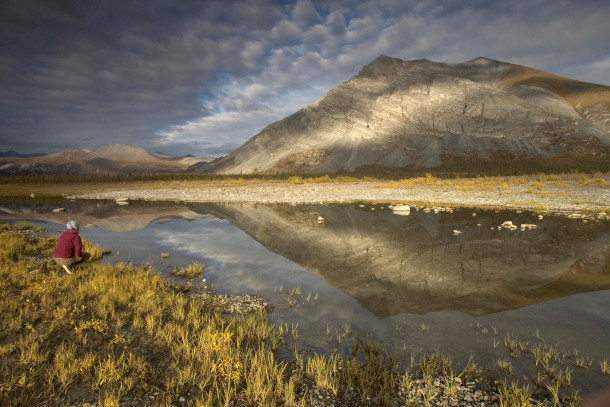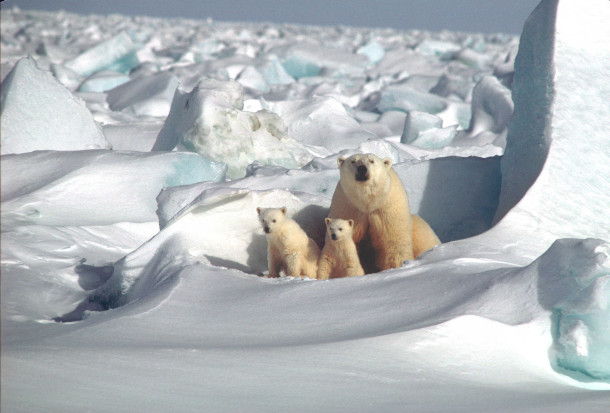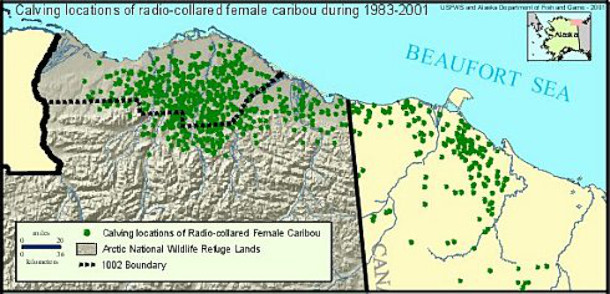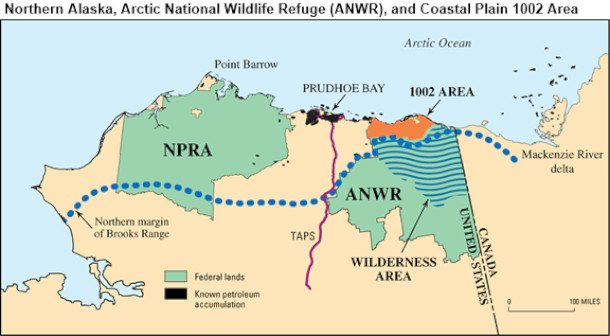ANWR Oil Leasing
Air Date: Week of January 8, 2021

The Arctic National Wildlife Refuge is one of the largest national wildlife refuges in the United States. It is considered one the country’s last untouched areas of wilderness. (Photo: Hillebrand, USFW, Flickr, Public Domain)
The Arctic National Wildlife Refuge likely has billions of gallons of oil under it and for decades it’s been one of the most high-profile environmental battles. Despite opposition from conservationists and native peoples, a judge allowed the Trump Administration to proceed with a January 6 auction of oil and gas drilling leases in the refuge. Anchorage Daily News Reporter Alex DeMarban joins Bobby Bascomb to talk about the ongoing litigation over ANWR.
Transcript
BASCOMB: So, Steve the elections in Georgia are a political game changer with Democrats in control of both houses of Congress and of course the presidency. But the Trump administration still had time for a last minute push to open up ANWR.
CURWOOD: Right, the Arctic National Wildlife Refuge, now there are potentially billions of gallons of oil under it and Republicans and the fossil fuel industry have been eyeing ANWR for decades.
BASCOMB: Exactly, but it’s a national wildlife refuge and a crucial habitat for wildlife like the porcupine caribou herd, which has the longest land migration on earth, 1500 miles long. And for the Gwich’in indigenous peoples, it’s known as “sacred land where life begins.” But supporters of oil drilling, especially Alaskan Republicans, claim opening ANWR to drilling is key to revenue and job creation. And as you said, this fight does goes back 4 decades but in 2017 the Alaska congressional delegation was able to get a sale of oil leases into the budget resolution bill, claiming it would generate 1 billion dollars of revenue for the government. Then in the next year several conservation and indigenous groups sued the Trump administration to try to block oil leasing in ANWR. But despite the lawsuits the Bureau of Land Management finally scheduled some ANWR lease sales for this January 6th. And on January 5th U.S. District Court Judge Sharon Gleason denied request for an injunction that would have delayed the bidding process until after president Trump leaves office. For more, let’s bring in Anchorage Daily News Reporter Alex DeMarban. Welcome to Living on Earth, Alex.
DEMARBAN: Thanks. Thanks for having me.
BASCOMB: Well, what exactly did judge Gleason say in this case? What was her rationale for ruling in favor of the Trump administration?
DEMARBAN: Gleason, interestingly, didn't I think focus on some of the arguments that the conservation groups had made, such as that the Trump administration did not study the emissions appropriately, that would come from oil development. So she instead focused on the fact that the conservation groups did not say that there would be immediate and irreparable harm, which was something that she needed if she was going to immediately halt the issuance of the leases. So rather than focusing on whether environmental steps have been overlooked, she had to focus on whether there was going to be irreparable damage caused by leases being issued to companies before she could make a decision. And she said that she had time to make a decision, if any such damage were to occur, she can make that decision before that damage might occur. So she focused on a very narrow part and said, it's not ready right now to be stopped.

Loss of sea ice due to global warming threatens the polar bears that live in the Arctic National Wildlife Refuge. Environmentalists and scientists believe that drilling for oil and gas in the refuge will only exacerbate the effects of climate change and further endanger polar bears. (Photo: Steven Arstrup, USGS, Public Domain)
BASCOMB: So basically, she's saying that the lease sale itself doesn't pose any imminent danger, because the company would still have to get another permit to begin seismic testing and then undergo, you know, an environmental impact statement, all of which I would think could take many years. Do I have that right?
DEMARBAN: Somewhat, she's saying that, yes, a lease sale won't cause immediate harm, and she can make a decision if it were to cause any harm before then. Not necessarily in years but maybe in months, for example, there's a seismic program that might take place this winter. And before any irreparable harm is done, she says she still has time to make a decision. She also said that that seismic exploration program isn't even approved yet. So there's nothing she can rule on there but she invited the conservation groups to try again, if they want to stop that once it is approved and she would consider that request. So it's not an into the case. It's just a very small part of the case in which she said, at least sale itself doesn't cause damage to the land, or to values in the refuge immediately.
BASCOMB: Alex DeMarban is a reporter for the Anchorage Daily News.
DEMARBAN: Yeah, thanks for having me. I appreciate it.
BASCOMB: So, Steve as Alex just told us drilling in the Arctic National Wildlife Refuge isn’t necessarily going to get started any time soon. But this decision keeps the possibility alive.
CURWOOD: Right the lease sales began the very next day after Judge Gleason gave her decision. What happened there?
BASCOMB: Well, there were 22 tracts of land available for lease sales but only half of them were actually purchased and none of the big oil companies put in a bid.

Caribou calving takes place in the coastal plain of the Arctic National Wildlife Refuge, where oil and gas drilling leases are underway. (Photo: U.S. Fish and Wildlife Service Wikimedia Commons, Public Domain)
CURWOOD: So, Bobby, tell us why.
BASCOMB: Well, there could be a few factors here. First, bowing to pressure from conservation groups, half a dozen financial institutions, including Bank of America, have pledge to not fund any Arctic drilling. So that means, extraction companies would largely have to invest their own money to work in the Arctic. And the price of a barrel of oil is quite low right now so there’s not a driving economic incentive for them to take on drilling in a remote controversial region like ANWR.
CURWOOD: Ok, so who did buy up these rights then?
BASCOMB: Two small companies bought one parcel each. One is Regenerate Alaska, which is an affiliate of an Australian oil company. And the Knick Arm Services, which appears to be a LLC based in Alaska but very little information is available on it. The biggest bidder was the State of Alaska itself. Oil is of course a big business in Alaska, the government relies heavily on extraction for both revenue and jobs. So the state-owned Alaska Economic Corporation bought the rights to 9 parcels of land, totaling roughly half a million acres. They paid the minimum of $25 per acre but will actually get half that money back as part of the sale.
CURWOOD: So, this isn’t exactly the windfall that the Trump administration hoped it would be.
BASCOMB: No, certainly not. The administration hoped this sale would bring in on the order of a billion dollars but it’s actually totaled less than 15 million. Mr. Trump himself has made opening ANWR a key part of his plan for expanding domestic oil production. So, this lack luster sale must come as a disappointment though of course he has far bigger concerns after the events of this week.
CURWOOD: Right! Well, what if anything can President Biden and the new Democratic majority Congress do to reverse course on drilling in ANWR now that there are a few oil leases?

The image above shows the area where oil and gas leases have been sold. The 1002 Area covers about 1.5 million acres, accounting for about 8% of the total area of ANWR. (Photo: U.S. Energy Information Administration, Wikimedia Commons, Public Domain)
BASCOMB: President-elect Biden has routinely said that he opposes drilling in the Arctic and he’s opposed to allowing new leases on any public land for that matter. There are some legal hoops that the lease buyers still need to jump through so if the sales aren’t finalized by inauguration day it’s possible that they could be blocked. A more long lasting solution though would be for the new congress to reverse the 2017 legislation that allowed the sale to move forward to begin with. And then of course work on a law to permanently protect the Arctic National Wildlife Refuge.
CURWOOD: I imagine there will be a lot things on their agenda.
BASCOMB: Yes, no doubt.
Links
Washington Post | “Trump Auctions Drilling Rights to Arctic National Wildlife Refuge On Wednesday”
Living on Earth wants to hear from you!
Living on Earth
62 Calef Highway, Suite 212
Lee, NH 03861
Telephone: 617-287-4121
E-mail: comments@loe.org
Newsletter [Click here]
Donate to Living on Earth!
Living on Earth is an independent media program and relies entirely on contributions from listeners and institutions supporting public service. Please donate now to preserve an independent environmental voice.
NewsletterLiving on Earth offers a weekly delivery of the show's rundown to your mailbox. Sign up for our newsletter today!
 Sailors For The Sea: Be the change you want to sea.
Sailors For The Sea: Be the change you want to sea.
 The Grantham Foundation for the Protection of the Environment: Committed to protecting and improving the health of the global environment.
The Grantham Foundation for the Protection of the Environment: Committed to protecting and improving the health of the global environment.
 Contribute to Living on Earth and receive, as our gift to you, an archival print of one of Mark Seth Lender's extraordinary wildlife photographs. Follow the link to see Mark's current collection of photographs.
Contribute to Living on Earth and receive, as our gift to you, an archival print of one of Mark Seth Lender's extraordinary wildlife photographs. Follow the link to see Mark's current collection of photographs.
 Buy a signed copy of Mark Seth Lender's book Smeagull the Seagull & support Living on Earth
Buy a signed copy of Mark Seth Lender's book Smeagull the Seagull & support Living on Earth

